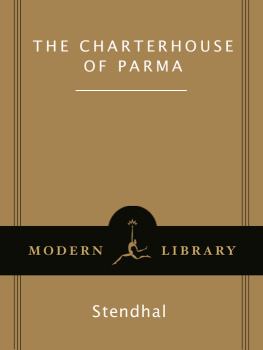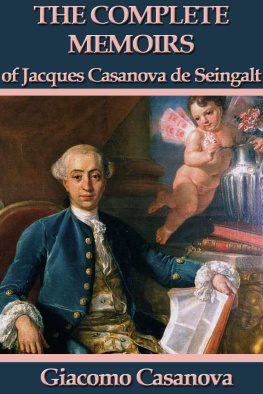

Fall River Press and the distinctive Fall River Press logo are registered trademarks of Barnes & Noble, Inc.
Foreword 2009 by Michael Dirda
Cover design by Cat Tale Productions
Cover art by J. J. Grandville; Granger Collection
All rights reserved. No part of this publication may be reproduced, stored in a retrieval system, or transmitted, in any form or by any means, electronic, mechanical, photocopying, recording, or otherwise, without prior written permission from the publisher.
ISBN 978-1-4351-4222-0 (e-book)
1 3 5 7 9 10 8 6 4 2
For information about custom editions, special sales, and premium and corporate purchases, please contact Sterling Special Sales at 800-805-5489 or specialsales@sterlingpublishing.com
www.sterlingpublishing.com
F OREWORD

T O THE WORLD , S TENDHAL IS THE NAME OF ONE OF THE worlds most eminent novelists, the author of The Red and the Black and The Charterhouse of Parma. Yet Stendhal is only one of many pen-names assumed by Marie-Henri Beyle, just as his two great novels are only a small portion of a sizable and varied literary output. While all serious readers admire the fiction of Stendhal, more than just a Stendhalian happy few also love the short, fat, and passionate Beyle, half sentimentalist, half cynical homme du monde.
Stendhalas its simplest to call himreveals his truest and most vulnerable self in his correspondence, journals, and such varied works as the treatise On Love, the polemical pamphlet (attacking the stultified French drama) Racine and Shakespeare, a chatty biography of Rossini (in which the digressions matter more than the narrative), several chronicles of the Parisian art scene, and a travel book called Walks in Rome. These, moreover, are just some of his writings published between 1821 and 1830, the time period covered by Memoirs of Egotism. This decade also includes Stendhals first novel Armance (about the daring subject of sexual impotence) and closes with his account of the rise and fall of a gifted young man from the provinces, The Red and the Black.
Despite all this literary activity, little of it earns a mention in Memoirs of Egotism. Stendhal is, in fact, the least self-aggrandizing author one can imagine. He doesnt push his books; he doesnt drop namesindeed, he disguises the identities of many of the people he writes about. During these Paris years, for example, Stendhal spent time with the visiting English essayist William Hazlitt (from whom he may have borrowed the word egotism), socialized with the Russian novelist Turgenev, and traveled back to Italy where he stopped off to see his friend the great poet Leopardi. The influential French critic Sainte-Beuve tells us that he attended a dinner party on January 2526, 1830, where he sat between Victor Hugo and Stendhal. You would think that such luminaries and gatherings might receive a paragraph or two in the Memoirs of Egotism, but you would be wrong. At least Stendhal does talk, all too briefly, about his close friend, the short-story writer Prosper Mrime, author of Carmen and The Venus of Ille.
So what does interest Stendhal? The short answer is his own psychology, the tricks and tics of the memory and the unconscious, his own contradictory nature, equally fascinated with role-playing and sincerity. Scribbled down in 1832, in just under two weeks, these recollectionsnever completed, like so many of Stendhals projectsare his first real attempt at autobiography (and would be succeeded by his masterpiece in the genre, The Life of Henry Brulard, which treats his childhood and youth). Having lived through the tumultuous Napoleonic era, spent years as a man about town in Milan and Rome, and attempted to make a living as an author during the Bourbon Restoration, the now middle-aged Stendhal suddenly finds himself the French consul in the small Italian town of Civita Vecchia. Bored, he decides to while away my leisure hours by recalling his Paris sojourn of the previous decade. He insists that he will scribble as fast as possibleturning out roughly thirty pages per sessionand not revise anything, aiming at the kind of authenticity and absolute truth denied more artful and polished pieces of writing.
In fact, the conversational roughness, the constant authorial questioning of motives, the interjection of second thoughts, the sudden shifts and swerves in the narrative, and all the other revelations of a mind actively brooding over its past are what give Stendhals Memoirs of Egotism its magical immediacy. Here is a heart laid bare. The reader, moreover, soon grows as interested in the actual process of revery as in what is being remembered: Where was I? Stendhal writes at one point, before adding, Heavens, how badly written this is! Elsewhere he notes that like a respectable woman turned harlot, I must constantly try to overcome the reserve that makes a gentleman reluctant to talk about himself. As always, Stendhals prose throughout is transparent and unadorned, and every sentence actually says something. For anyone who has had a taste of the absorbing occupation of writing, there is only a secondary pleasure to be extracted from reading. Often, while at work, I have thought it was only two oclock when a glance at the clock showed that it was half-past six. This is my only excuse for having blackened so much paper with ink.
At one point Stendhal compares the Memoirs to an examination of conscience, but more accurately it might be called a psychological case-history: This, says Beyle, is how I gradually recovered from my almost suicidal passion for Metilda (an Italian beauty who never even granted him her favors). He does this largely by plunging into a social whirl, made up of now-forgotten cronies, evenings at various salons, and the eventual consolations of new love affairs. To the Parisian society of his time, Stendhal was chiefly known as a witty cynic, with a taste for fashionable clothes. In his own view, he needed his intelligence and wit and splendid dress to compensate for his shortness (he was under five feet, five inches) baldness, obesity, and general lack of good looks. Plus he was now in his late forties, a crisis age for those who, like Stendhal, find that nothing in life matters so much as the promise of happiness in the arms of women. Only the music of Mozart and Cimarosa, the plays of Shakespeare, and the paintings of Tintoretto, he tells us elsewhere, have ever provided him with anything close to the pleasure of falling in love. And as he says here, it bores me to write of anything but the analysis of the human heart.
So lovelost, sought, or purchasedis a dominant theme throughout the Memoirs. Among the books highlights are Stendhals chapter about his total fiasco when attempting to enjoy the beautiful courtesan Alexandrine, his portrait of the elderly General Lafayette (who likes to pinch the bottoms of pretty young girls), an idyllic account of love in a cottage during a journey to England, and numerous brief anecdotes about the sexual histories and proclivities of the socially prominent:
Mme. Lavanelle was as dry as a stick, and besides she had no wit, and was incapable of real passion; the only thing that could excite her was a glimpse of the handsome thighs of a company of grenadiers in white cashmere breeches as they marched through the Tuileries Gardens.
One day the eight or ten nieces of Mme. de Montcertin asked her: What is love? To which she replied: It is a low, vile thing, of which chambermaids are sometimes accused, and when they are guilty, we send them packing.
Next page











